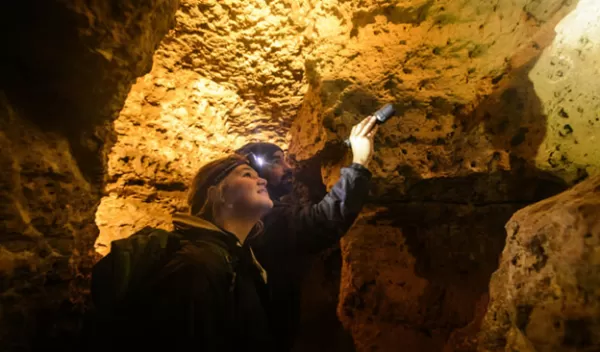
Wisconsin cave holds tantalizing clues to ancient climate changes, future shifts
Even in their dark isolation from the atmosphere above, caves can hold a rich archive of local climate conditions and how they've shifted over the eons. Formed over tens of thousands of years, speleothems — rock formations unique to caves better known as stalagmites and stalactites — hold secrets to the ancient environments in which they formed.
A U.S. National Science Foundation-supported study of a stalagmite found in a cave in southern Wisconsin reveals previously undetected history of the local climate going back thousands of years. The findings provide strong evidence that a series of massive and abrupt warming events that punctuated the most recent ice age likely enveloped vast swaths of the Northern Hemisphere.
Researchers analyzed a specialized microscope image of annual growth bands in the speleothem. The bright and dark bands represent differences in organic acid content. The difference in organic acid content from dripwater is due to seasonal changes in the overlying soil.
The research, conducted by a team of scientists at the University of Wisconsin–Madison, appears in the journal Nature Geoscience. It's the first study to identify a possible link between ice age warm-ups recorded in the Greenland ice sheet — known as Dansgaard-Oeschger events — and climate records from deep in the interior of central North America.
"This is the only study in this area of the world's recording of these abrupt climate events during the last glacial period," says co-author Cameron Batchelor of the Massachusetts Institute of Technology.
The study is based on a detailed chemical and physical analysis of a stalagmite that formed in the Cave of the Mounds, a tourist attraction and educational destination. The stalagmite the team analyzed grew extremely slowly — taking roughly 20,000 years to reach the length of a human pinky finger.
The finger-length subterranean rock formed from a complex process that began in the sky. Water that originally fell as precipitation from the atmosphere soaked into the ground and percolated through soil and cracks in bedrock, dissolving tiny bits of limestone along the way. Some of that dissolved limestone was then left behind as countless drips of water fell from the ceiling of Cave of the Mounds, gradually accumulating into thousands of exceedingly thin layers of a mineral called calcite.
Therein lies the key to reconstructing an ancient climate record. The oxygen trapped in the calcite exists in varieties — known as isotopes — scientists can use to glean information about the environmental conditions during the precipitation that formed it. That includes the temperature and possible sources of rain and snow that fell atop the Cave of the Mounds over thousands of years.


